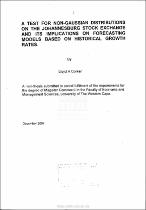| dc.contributor.advisor | Huda, S | |
| dc.contributor.author | Corker, Lloyd A | |
| dc.date.accessioned | 2020-11-11T13:40:03Z | |
| dc.date.available | 2020-11-11T13:40:03Z | |
| dc.date.issued | 2002 | |
| dc.identifier.uri | http://hdl.handle.net/11394/7447 | |
| dc.description | Masters of Commerce | en_US |
| dc.description.abstract | If share price fluctuations follow a simple random walk then it implies that forecasting models based on historical growth rates have little ability to forecast acceptable share price movements over a certain period. The simple random walk description of share price dynamics is obtained when a large number of investors have equal probability to buy or sell based on their own opinion. This simple random walk description of the stock market is in essence the Efficient Market Hypothesis, EMT. EMT is the central concept around which financial modelling is based which includes the Black-Scholes model and other important theoretical underpinnings of capital market theory like mean-variance portfolio selection, arbitrage pricing theory (APT), security market line and capital asset pricing model (CAPM). These theories, which postulates that risk can be reduced to zero sets the foundation for option pricing and is a key component in financial
software packages used for pricing and forecasting in the financial industry. The model used by Black and Scholes and other models mentioned above are Gaussian, i.e. they exhibit a random nature. This Gaussian property and the existence of expected returns and continuous time paths (also Gaussian properties) allow the use of stochastic calculus to solve complex Black- Scholes models. However, if the markets are not Gaussian then the idea that risk can be. (educed to zero can lead to a misleading and potentially disastrous sense of security on the financial markets. This study project test the null hypothesis - share prices on the JSE follow a random walk - by means of graphical techniques such as symmetry plots and Quantile-Quantile plots to analyse the test distributions. In both graphical techniques evidence for the rejection of normality was found. Evidenceleading to the rejection of the hypothesis was also found through nonparametric or distribution free methods at a 1% level of significance for Anderson-Darling and Runs test. | en_US |
| dc.language.iso | en | en_US |
| dc.publisher | University of Western Cape | en_US |
| dc.subject | Stable distribution | en_US |
| dc.subject | Heavy-tail | en_US |
| dc.subject | Capital Market | en_US |
| dc.subject | Theory Gaussian | en_US |
| dc.subject | Symmetry Infinite variance | en_US |
| dc.subject | Continuous time paths | en_US |
| dc.subject | Diffusion processes | en_US |
| dc.subject | Central Limit | en_US |
| dc.subject | Theorem Arbitrage | en_US |
| dc.title | A test for Non-Gaussian distributions on the Johannesburg stock exchange and its implications on forecasting models based on historical growth rates. | en_US |
| dc.rights.holder | University of Western Cape | en_US |

